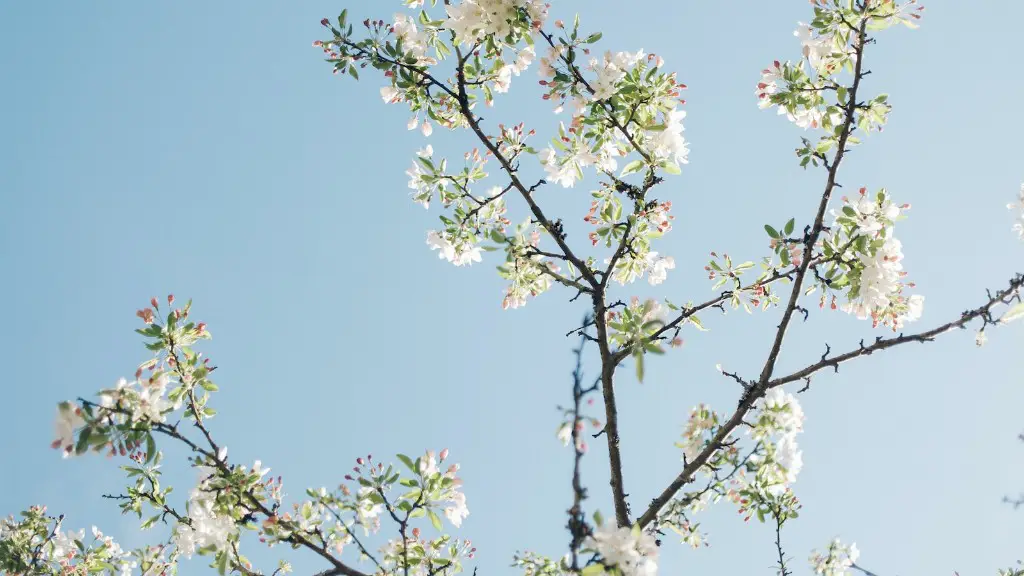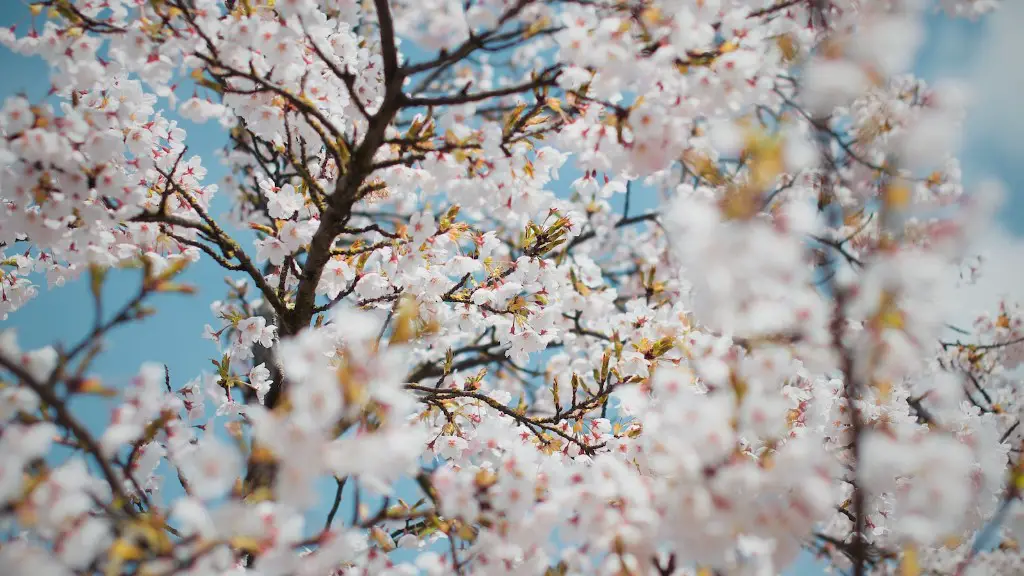It is important to prune sour cherry trees to ensure they remain healthy and productive through the years. Pruning a sour cherry tree can be quite simple but it is important to get it right in order to get the best results. Here we explore the basics of how to prune a sour cherry tree.
The most important step when pruning a sour cherry tree is to identify the main scaffold branches – these should be the strongest branches and should be selected carefully to ensure the tree can easily bear the weight of all the fruits. The objective is to eventually have four or five main scaffold branches radiating out from the tree’s center. As a general guide, each branch should be about 45 degrees off the last one so that the tree can be easily managed. It is important to avoid the temptation to give the tree a ‘perfect’ symmetrical shape, as this may impact negatively on the tree’s health.
The next step is to prune any vertical stems or any stems that cross each other. It is important to also remove any diseased, dead or damaged branches as soon as possible as they can present a greater risk of infection to the tree. The aim is to ensure the tree looks healthy and natural, and that it has an even spread of branches.
It is also important to avoid pruning too late in the season, as this can lead to the tree bleeding sap, which can then lead to disease or infection. The ideal pruning season for a sour cherry tree is during late summer or autumn, typically between August and November. It is also important to remember that timing of pruning is also largely dependent on the weather in specific area as later prunings carried out in cool or wet areas can be particularly risky.
When it comes to the actual pruning, it is important not to simply ‘lopp off’ branches as the cuts should be made in a certain way so as to avoid damaging the branch collar. The branch collar is the base of the branch, at the point where it joins the main stem, and any damage here can lead to infection or decay. When pruning, pruners should be made close to and parallel with the branch bark ridge. Make sure to also space out the cuts at different levels so that the branch can branch out in a natural pattern and that the desired shape can be created.
Experts advise never pruning more than a third of a tree in any given pruning session and to leave some smaller branches (about pencil thick) in order to encourage better fruit production. It is also important to note that sour cherry trees not need be pruned every year – pruning should be done as and when necessary and to keep an eye on the overall health and shape of the tree.
Protecting The Tree form Infection
Infection is a major threat to any tree, and it is very important to take steps to minimise the chances of infection when pruning a sour cherry tree. This starts with using clean, sharp pruning tools and ensuring that the pruning tools are regularly disinfected with either 70% alcohol or a fungicidal wash. This will help to prevent disease spread between trees and plants. Always cut away any diseased or dead branches, and never leave them on the ground as they can become an ideal breeding ground for diseases.
To further prevent infection, avoid making too many pruning cuts at a time and avoid removing too much of the tree’s canopy in order to limit the amount of new growth which can lead to an increased risk of diseases.
Finally, it is important to protect your tree from other threats such as herbicides and pests, as well as extreme weather conditions, such as heavy winds and ice, that can damage branches and leave the tree exposed.
Pruning in Winter
Winter pruning can also be very important in taking care of a sour cherry tree, and this is typically done in late winter or early spring before the tree begins to bloom. The aim of winter pruning is to encourage thicker and more fruitful branches. When pruning a sour cherry tree in winter, aim to thin out any secondary branches that are crossing and growing too closely together.
It is also important to keep an eye on the top of the tree, as while it is important to prune branches to maintain an even shape, it is also important not to prune the crown too much. This is because the crown plays an important role in providing shade and nutrients to the rest of the tree. The aim of winter pruning should be for the tree to look natural and full – with an equal spread of branches.
In addition to pruning, it is also important to carry out routine maintenance on the tree, such as fertilising and watering regularly. This will help to ensure the tree remains healthy and productive, and will help to reduce the chances of infection.
Pruning as a Way of Growing
Pruning a sour cherry tree is an important part of keeping the tree healthy, but it is also important to remember that it can be a way of promoting growth too. Pruning can help to encourage thicker and more plentiful branches, meaning more fruits can be produced. Pruning also encourages more light to reach the inner parts of the tree so that the extra fruits can mature faster.
Furthermore, pruning can also help to shape the tree so that it is easier to manage and harvest the fruits. Pruning in winter can also help to encourage buds to bloom sooner and faster, meaning that the harvest period for the sour cherry tree can be brought forward.
Pruning Tools
When it comes to pruning tools, it is important to select ones that are suitable for the job. This means opting for tools which are designed for pruning trees and are of good quality – with specialist tools such as loppers and pruners also being essential for precise cuts.
It is also important to remember to keep the tools clean and sharp. Clean tools will help to reduce the risk of infecting the tree with any bacteria or fungi, while sharp tools will make the pruning job quicker and easier, as well as reducing the risk of cutting incompletely and leaving the bark ridge or branch collar exposed.
Finally, it is also important to make sure that the pruning tools are properly maintained and stored after use so that they remain in good condition.
Harvesting
Harvesting the fruits of a sour cherry tree is one of the most rewarding and enjoyable parts of being a tree owner. Sour cherries, like many other fruits, can be harvested when the fruits have reached their peak in terms of sweetness and size. As a general rule of thumb, the fruits should be harvested when they are slightly softer than when they are ripe.
It is important to remember that different cherry varieties will ripen at different time and so, it is important to familiarise yourself with the ripening times of the variety you have planted. Ultimately, one of the best ways to tell when the fruit is ready for harvest is to sample a few cherries – once the colour ripens and the taste is sweet, it is time to begin harvesting!
When harvesting sour cherries, use pruning shears or scissors to cut the fruits off the tree, being careful to ensure the fruit is cut rather than pulled or twisted off. Place the fruits into paper bags or a box to ensure they don’t get crushed under their own weight, and remember to also store them in cool, dark places away from direct sunlight.
Storing and Preserving
Once the fruits have been harvested, they should be consumed or stored as soon as possible in order to reduce the chances of decay or spoilage. Fruits that won’t be eaten immediately should be stored in a cool place in an airtight container – ideally in the refrigerator if possible. Sour cherries can be frozen for future use and these can either be left whole or pitted and pitted prior to freezing.
Sour cherries can also be preserved in the traditional way through canning or dehydration, too. Fruits should be prepared by pitting and then cooked with a suitable preservative or with a sugar syrup to help keep the fruits intact. Once these fruits have been prepared and canned, they can last for months – depending how they were stored and preserved.
Conclusion
Pruning a sour cherry tree is an important part of its maintenance and health, and understanding how to do this properly is essential to ensure a good crop of fruits is produced for years to come. Understanding the process of pruning, protecting the tree against infection, pruning in winter, using the right tools and harvesting and storing the fruits are all important aspects of the process of maintaining a sour cherry tree.




